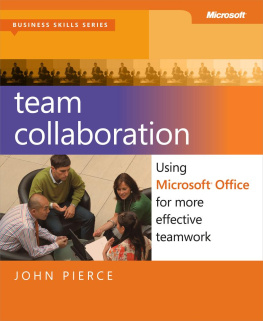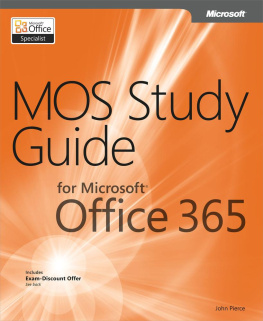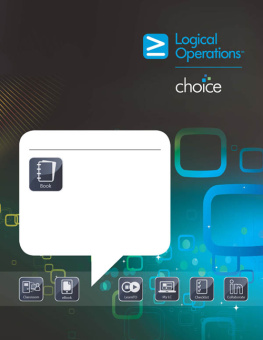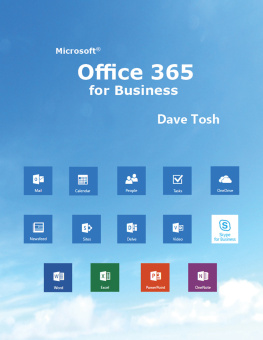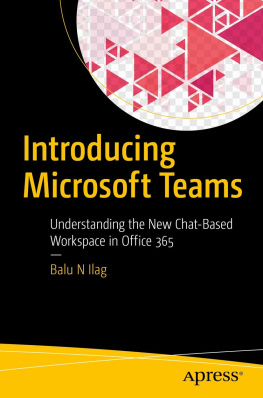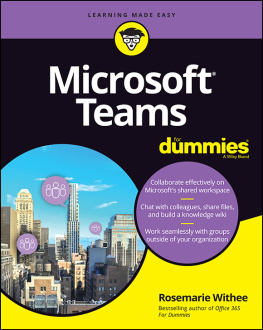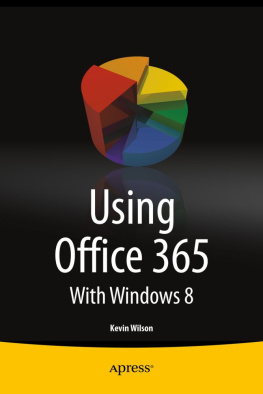Introduction
THE EXPERIENCE OF working on a team can be deeply rewarding and deeply frustratingand sometimes both at the same time. Team members can leave a meeting feeling good about themselves when theyve solved a particularly difficult issue or seen the results of a new process that alleviated redundant work or reduced the number of errors. On the other hand, the imperative of getting work done on schedule can lead to miscommunications and misunderstandings, undocumented shortcuts, abbreviated reviews, or just sloppy preparationexperiences that can damage a teams spirit and its reputation. In these cases, team members need to have a system in place that allows them to do more than promise to avoid similar mistakes in the future.
On its own, Microsoft Office cant ensure that a team works together effectively. Team dynamics, leadership, clarity of goals, and other mostly intangible factors play a large role in that. But having a tool such as Office at the center of how a team produces its work does provide support for important needs, including access to information, ease of communication, and content management (such as document versions, reviews, workflows, and approved publishing).
In Team Collaboration: Using Microsoft Office for More Effective Teamwork , youll learn about these and other capabilities in Officeand also receive some advice about the nature and goals of teamwork.
The nature of work in general has changed as the result of worker mobility, the use of mobile computing devices, cloud computing and services, and the predominance of teamwork of all sorts. To meet these needs, the programs in Office have steadily evolved to facilitate collaboration. As youll see as you read this book, Office is no longer designed with the assumption that youll use it all on your ownat least for very long. At times, of course, youll be at your PC, typing a document, preparing a presentation, or crunching numbers. But in most cases, the results of these activities will soon be shared with your coworkers, not to mention with managers, partners, vendors, and others.
And sharing work is often just the beginning of effective collaboration. What I hope you gain from this book is an understanding of how the capabilities in Office let teams share work in contextto help gather opinions, set goals, manage time, and facilitate decisions.
Who this book is for
Team Collaboration: Using Microsoft Office for More Effective Teamwork is intended for individuals and groups who want to know how to use Office to facilitate the work they do as a team. In this context, team could mean a small business (say, 5 to 12 people), a department within a larger organization, a project team made up of individuals from several different departments, or a group of independent contractors working together on one or more projects.
I use the term project frequently in this book to refer to the work teams do together. In many cases, this might be a true project (an activity with a defined set of goals and with specific start and end dates), but I also intend project to refer to the ongoing work of a teamwork that is structured by tasks and the creation, review, and approval of documents and information.
And, of course, this book is intended for teams that create content in Office as one of their principal activities. This covers a broad spectrum of job roles and industries, including (but not limited to) sales, marketing, legal work, insurance, publishing, retail, engineering, government and public policy, nonprofits, and education.
Assumptions
This book contains both descriptive information that highlights capabilities in Office and some step-by-step procedures that lead you through a series of commands to execute a particular task. Ive written this book assuming that readers are familiar with the general Office user interface or are learning it by consulting another source. You should at a minimum understand the structure of the Office ribbon and how it is organized in tabs and groups of commands.
Advanced users of Office will likely already work with many of the features described in the book. This book also does not cover any Office administration tasks. It does not describe how to centrally administer a SharePoint site collection, for example, or how to configure Lync Server or Exchange Server. Readers who need this information should turn to Microsoft TechNet (www.microsoft.com/technet) or other books from Microsoft Press.
How this book is organized
This book is organized in two parts. , includes the books first four chapters. It provides background information about how people work as a team and describes steps teams can take in Office to set up the tools they use to manage their work over time.
, describes factors that influence team dynamics, how teams can avoid groupthink, the use of brainstorming techniques, and other aspects of working as a group. This chapter also introduces some of the collaboration capabilities in Office.
, covers details of how a team site can facilitate collaborative work, including how to work with a document library, how to track and manage tasks, and how to conduct a team discussion in SharePoint. This chapter also covers how to set up a workflow to manage document approval as well as other capabilities in SharePoint.
also returns to the discussion of SharePoint to cover how to implement versions and approved publishing on a team site.
, explains why templates are useful in coordinating the work a team does. It covers how to find and work with the templates that come with Office; describes elements and features that make up templates in Excel, PowerPoint, and Word; and offers examples of how to build templates from scratch.
, respectively, cover collaborative features in Word, Excel, and PowerPoint. In these chapters youll learn about coauthoring, a feature that enables more than one person to work on a file at the same time, in addition to more conventional collaborative features such as comments, revision marks, and combining and comparing files.
, provides an overview of the capabilities available on SkyDrive, Microsofts cloud service that provides storage, versioning, e-mail (under most circumstances), a calendar, and a contact list. Youll also learn more about Office Web Apps, which are web-based versions of the desktop programs that let you work with documents in a web browser.
Reading this book in chapter order is not necessary, but the book is designed (especially in .
Office versions and requirements
The screen shots and procedures in this book are based on the Office 2013 Preview available during the summer and early fall of 2012. Keep in mind that the appearance of Office and the steps you follow to complete a task might be different in the final version that is released.
Some of the programs discussed in this book require server systems to run. These include SharePoint and Lync. In addition, some of the features described for Outlook are tied to using Outlook on Exchange Server. You can find information about online hosting services for SharePoint and Lync on Microsofts website. You can also find information about third-party hosting solutions on the web.
Acknowledgments
Thanks to Rosemary Caperton, Valerie Woolley, Megan Smith-Creed, and Jorge Diaz for their help organizing, editing, and producing this book. Thanks also to Charles Schwenk for his conversations over the years, especially regarding the nature of groups and organizations, and to Lucinda Rowley, who exemplifies a collaborative spirit. On the home front, gratitude to MC, Fox, and Holly.

